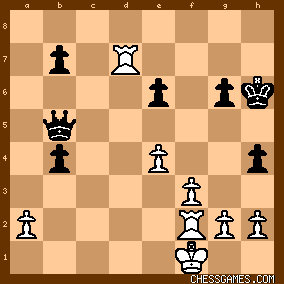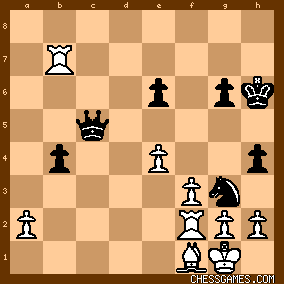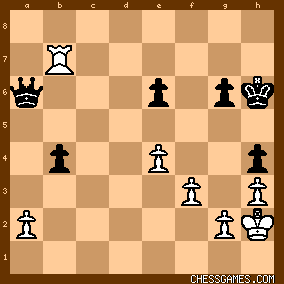|
< Earlier Kibitzing · PAGE 5 OF 5 ·
Later Kibitzing> |
Oct-25-11
 | | Jimfromprovidence: In the position after 41 Rxf7+? Kh6, notice that white can't play 42 Rd7, below (seeing 43 Rd2 to help defend the pinned rook). 
click for larger viewBlack answers with 42...Nxf1! (seeing 43 Kxf1 Qb5+, winning the rook.) 
click for larger view |
|
| Oct-25-11 | | Marmot PFL: I agree with kevin, it's pretty basic. The knight can't be captured, but black has no way to improve the position so needs a knight move to attack the rook (Nxf1 Kxf1 Qc1+ Ke2 goes nowhere). 42...Nh2 43 Kxh1 Qxf2 and the game is over, even if the rook could somehow protect Bf1 then Qxa2 and pushing the b-pawn is an easy win. |
|
| Oct-25-11 | | sevenseaman: Today's POTD presents just the kind of position that many composed puzzles keep on repeating tirelessly, even ad nauseum may be. In OTB games though it is a rare occurrence. I couldn't recall any game other than Piket-Kaparov(though now I know some more). But the moment I saw the position today, the solution was crystal clear to me in a flash. |
|
| Oct-25-11 | | Mozart72: Sorry guys to budge in.... Black won the game with several theoretical chess pieces: B or N. Or B + P or N + P. White's final material value: 12.5, Black's: 16.1. If 16.1 - 12.5 = 3.6, without rounding to the nearest whole number = 3. And a three in the standard chess piece relative value scale is equal to a B or a N. If 3.6 is rounded then 3.6 = 3 + 0.6 = 3 + 1. And a 3 in the standard chess piece relative value scale can be a B or a N and 1 a P. So we have a theoretical Bishop, a theoretical Knight, a theoretical Bishop + Pawn, and a theoretical Knight + Pawn as a material advantage value for Black. |
|
| Oct-25-11 | | jerman88: Please explain why 32.Qxc5.
What's the point of giving up the queen? |
|
| Oct-25-11 | | bronkenstein: <jerman88: Please explain why 32.Qxc5.
What's the point of giving up the queen?>
White gives his queen for 2 rooks , avoiding the alternative 32. Rxc5 Rxa2 (important intermediate) 33.Qg3 (the mat was threatening) dxc5 and white is practically out of moves. |
|
Oct-25-11
 | | chrisowen: Signal hacking bet Nh1 traffic sigh six pack jam angle for Quang golden arm spread it in your tree rf2 forget it heavy mone let venom rf7 decisive cap inuendo join knight foot mob. |
|
| Oct-25-11 | | TheBish: L Lenic vs Le Quang Liem, 2011 Black to play (42...?) "Easy"
White is actually slightly ahead in material, with two rooks and a pawn for a queen (remaining material being equal). However, White's Rb7 is a little out of the picture, being no help on defense. Also, Black need not worry about White playing hxg3 as ...hxg3 in reply wins the game. Candidates: ...Qd4, Nh1
It looks like both moves work, but probably one is at least slightly better. If 42...Qd4 (threatening 43...Nxf1 44. Kxf1 Qd1#), White has 43. Rxb4 Qxb4 44. hxg3 hxg3 45. Rc2 (or 45. Re2 Qc5+ 46. Kh1 Qh5+ 47. Kg1 Qh2#) Qd4+ 46. Kh1 Qd1 and wins. Also (after 42...Qd4) 43. Rd7 is no better: 43...Qxd7 44. hxg3 hxg3 45. Rc2 (Re2) Qd4+ 46. Kh1 Qd1 wins the same way. But White can hold out longer with 43. Rc7 Nxf1 44. Rc1 Ng3! with the threat of 45...Nh1. But why not just play that last move first? 42...♘h1!
I think this is slightly more accurate, as far as the fastest win goes. The threat is 43...Qxf2+ 44. Kxh1 Qxf1#, and if 43. Kxh1 Qxf2, forced is 44. h3 (44. Bc4 Qe1+ mates) Qxf1+ 45. Kh2 Qe1 and Black will win, up a queen for a rook and pawn. The quickest win from here would be to activate the king to either assist in a mating attack or winning the a2 pawn to eventually win the rook. |
|
| Oct-25-11 | | TheBish: Slight correction: After 42...Nh1! 43. Kxh1 Qxf2 44. h3 Qxf1+ 45. Kh2 the quickest win from here is not 45. Qe1, but 45. Qa6! (pointed out by Fritz and others here), driving off the rook (45...Rxb4 or 45...Rb8 46. Qd6+ wins the rook) followed by 46. Qxa2. |
|
| Oct-25-11 | | master of defence: Instead of 31. Rf2 what happens if white play 31.Kh1? I don't see anything continuation winner for black. |
|
| Oct-25-11 | | Patriot: <TheBish> 42...Qd4 is a very sneaky threat. 43.Bb5 forces black to prove his point since after 43...Qd1+, 44.Bf1 can be played. |
|
| Oct-25-11 | | Patriot: <master of defence> <Instead of 31. Rf2 what happens if white play 31.Kh1? I don't see anything continuation winner for black.> It's not easy to see. 31.Kh1 Qd1:
A) 32.Rc1 Rxa5 33.Rxd1 Rxg5 (33.Qxa5 Qxc1) wins a piece. B) 32.Qc1 Qxc1 33.Rxc1 Rxa5  (wins a rook) (wins a rook)
C) 32.Rf2 Qe1 33.Rxa8 Qxf2 34.Qc1 Rxa8  (winning a rook) (winning a rook) |
|
| Oct-25-11 | | Patriot: <master of defence> After running it through Houdini, there is a tricky defense I didn't see... 31.Kh1 Qd1 32.Rc1 Rxa5 33.Qe3! is the only move, giving black only a slight advantage. Everything else loses. |
|
| Oct-25-11 | | howlwolf: This reminds me of one my favorite Raymond Keene stories where he talks about trying to emulate Nimzovitch, who played this in a famous game; was it against Rubenstein? I got this one quickly but I probably looked at the GOTD a few months ago. |
|
| Oct-25-11 | | morfishine: <Jimfromprovidence> Nice spot on 42.Rd7 <Patriot> & <master of defence> Very good on that continuation with <31.Kh1> after 30...Qd4+ |
|
| Oct-25-11 | | master of defence: Thanks Patriot. Now i know the best continuation for white is 31.Kh1 Qd1 32.Rc1 Rxa5 33.Qe3 and black is forced to play 33...Qxc1 34. Qxc1 Rxa2 with small advantage for black. |
|
| Oct-25-11 | | master of defence: Well kibitzers i'm brazillian maybe for this i don´t speak english very well. who can help me with english speak with me on my forum.
Thanks for all! |
|
| Oct-26-11 | | SuperPatzer77: <TheBish: Slight correction: After 42...Nh1! 43. Kxh1 Qxf2 44. h3 Qxf1+ 45. Kh2 the quickest win from here is not 45. Qe1, but 45. Qa6! (pointed out by Fritz and others here), driving off the rook (45...Rxb4 or 45...Rb8 46. Qd6+ wins the rook) followed by 46. Qxa2. > <TheBish> Yes, you're absolutely right. I used Fritz 5.0 for the analysis. Black's strong move is 45... Qa6! to drive the White Rook off and to win the White a-pawn. Then the Black b-pawn is getting ready to go queening. <TheBish> You use the wrong color - it should be Black - 45...Qa6! (not 45. Qa6!) so, your remark got me a little confused because of the wrong color. SuperPatzer77 |
|
| Oct-26-11 | | morfishine: <master of defence> On Your comment: <...who can help me with english speak with me on my forum. Thanks for all!> You will need to activate your forum to post and receive postings. After that, feel free to post English sentences at my forum and I will reply with any corrections. Hope this helps! :) Morf |
|
| Oct-26-11 | | Elrathia Kingi: Another game that features throwing a knight into a corner as part of a winning attack (though not the finale): Kotov vs Keres, 1950 |
|
| Oct-31-11 | | SuperPatzer77: 
click for larger viewBlack to move - 42...Nh1!
After 42...Nh1! White resigns in lieu of 43. Kxh1 Qxf2, 44. h3 (forced - avoid getting mated) Qxf1+, 45. Kh3 -> see diagram below: 
click for larger viewBlack's strong reply is 45...Qa6! (driving the White Rook off and winning the White a-pawn) -> see diagram below: 
click for larger viewAfter 45...Qa6! White has four tries but loses his own rook below: a) 46. Rxb4 Qd6+, 47. Kg1 Qxb4 
b) 46. Rb8 Qd6+, 47, Kg1 Qxb8 
c) 46. Rc7 Qd6+, 47. Kg1 Qxc7 
d) 46. Re7 Qd6+, 47. Kg1 Qxe7 
White has two other tries but the Black b-pawn is ready to go queening below: a) 46. Rd7 Qxa2 
b) 46. Rf7 Qxa2 
SuperPatzer77 |
|
| Jan-28-13 | | Whitehat1963: What a comical finish! |
|
| May-10-14 | | celtrusco: Is possible 16-Nd5 ? |
|
| May-30-15 | | siggemannen: There's a Kasparov game where he does this Nh1 as well |
|
| Oct-19-15 | | mikealando: Yes <Siggemannen>. The game ends like the Kasparov - Piket classic: Piket vs Kasparov, 1989 |
|
 |
 |
|
< Earlier Kibitzing · PAGE 5 OF 5 ·
Later Kibitzing> |





